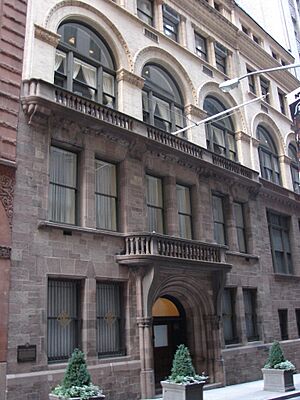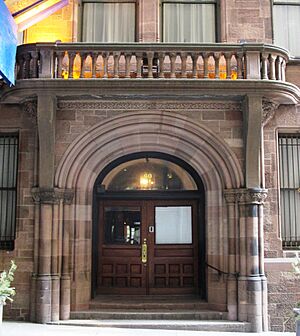Down Town Association facts for kids
The Down Town Association in the City of New York, often called the Down Town Association or just the DTA, is a special private club in the Financial District of Manhattan, New York City.
It is located at 60 Pine Street, between William and Pearl Streets. This club is the fifth oldest private club in New York. It was also the very first private club started in lower Manhattan back in 1859.
The building it uses today, which opened in 1887, was the first building ever built specifically for a private club in New York City. Before this, most clubs rented space in old houses or mansions.
History of the Club
The idea for the Down Town Association started at a meeting on December 23, 1859. The club officially held its first general meeting on February 14, 1860. It received its official permission to operate from the New York State legislature on April 17, 1860.
The club's current building opened its doors on May 23, 1887. In 1902, the inside of the building was updated. Later, in 1911, an addition was built. This new part added more private dining rooms and a beautiful reading room.
For a long time, until 1995, the DTA was mainly a club where members would go for lunch. Today, it is one of the few private clubs left in Lower Manhattan. It now offers dinner and events in the evenings, has a gym on the top floor, and is open all day from breakfast to evening drinks. Originally, only men could be members, but women have been welcomed as members since 1985.
The Clubhouse Building
The club's building is designed in a style called Romanesque Revival. It became a New York City landmark in 1997, meaning it's a very important historical building. This clubhouse is the oldest one in New York City that was built for and is still used by its members. It is also the third oldest such clubhouse in the entire United States.
Inside the Clubhouse
When you enter the clubhouse on Pine Street, you step into a lobby with marble details and a floor made of mosaic tiles. A special cast iron staircase goes up four floors from the back of the lobby. A large bar and lounge area, decorated with white oak wood, is just a few steps down from the staircase. This area is a main gathering spot for members.
On the second floor, you'll find the Reading Room, the Pine Street Room, and the larger Wainwright Room, which is now used as the club's ballroom. The third floor has the A la Carte Dining Room, the Buffet Room, and the Babcock Room, named after Samuel D. Babcock, an early president of the club. On the fourth floor, there are six private dining rooms and the Game Room. The Game Room is now only for members and has pocket billiards tables, other game tables, a bar, and a collection of hunting trophies. A fitness area was added on the fifth floor.
In the past, the first floor was used for getting ready for lunch, like checking coats or visiting the barber. The Reading Room was mostly used after lunch for coffee, port, or a nap. All other rooms were for serving lunch, and each had its own menu. Meals were brought up from kitchens on the fifth floor using a system of dumbwaiters, which are small elevators for food. As the club changed from just serving lunch to being open all day, the kitchen was moved. Some dining rooms were then changed into spaces for meetings, banquets, and the gym.
Famous Members
Many important business leaders from New York have been members of the Down Town Association. Some of them also went on to work in public service. A lot of the members come from legal and financial jobs.
The club has included important political and business figures from New York. These include Franklin D. Roosevelt and Grover Cleveland, who both served as New York governors and U.S. presidents. Other members were Thomas E. Dewey, a New York governor; Wendell Willkie, a lawyer and businessman; and William J. Donovan, who was the first director of the Office of Strategic Services. Gherardi Davis, a lawyer, author, and politician, was also a member and gave the club his large collection of silver items. The club has also had members who served as high-ranking government officials, including four secretaries of state and five attorneys general.
See also
- List of American gentlemen's clubs



